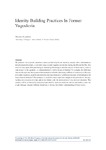Mostrar o rexistro simple do ítem
Identity building practices in former Yugoslavia
| dc.contributor.author | Albertini, Matteo | es_ES |
| dc.date.accessioned | 2014-10-02T12:31:20Z | |
| dc.date.available | 2014-10-02T12:31:20Z | |
| dc.date.issued | 2012 | es_ES |
| dc.identifier.citation | Culture of communication / Communication of culture, 2012: 303-312. ISBN: 978-84-9749-522-6 | es_ES |
| dc.identifier.isbn | 978-84-9749-522-6 | es_ES |
| dc.identifier.uri | http://hdl.handle.net/2183/13321 | |
| dc.description.abstract | [Abstract] My proposal for our panel concerns a particular kind of political practices, namely public demonstration and procession developed, in different ways, in each Yugoslavian republic during the 80s and the 90s. This point of view, apart from permitting an interesting deepening in semiotic studies of these topics, could at least answer to the question: is a demonstration in itself a source of identity? In example, the difference between the style and the course of demonstrations in Serbia (the famous Miloševic’s mitintsi), in Slovenia or in other countries, could be interpreted as the manifestation of a different trajectory of identification for these national identities? This perspective could develop a significant insight in the processes of identitybuilding in a situation of crisis, and in its relation with the construction of new political practices. This research will be performed by instruments provided by latest sociosemiotic and cultural studies, aware that a tight dialogue between different disciplines is the key for a better understanding of these events | es_ES |
| dc.language.iso | eng | es_ES |
| dc.publisher | Universidade da Coruña | es_ES |
| dc.title | Identity building practices in former Yugoslavia | es_ES |
| dc.type | info:eu-repo/semantics/conferenceObject | es_ES |
| dc.rights.access | info:eu-repo/semantics/openAccess | es_ES |






